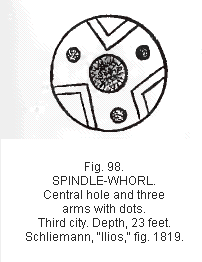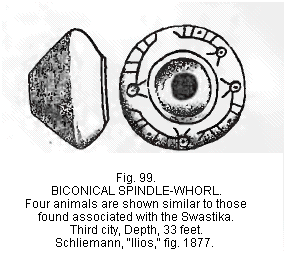

The Swastika
Dispersion of the Swastika
 mythology in everything. Fig. 98 is the same style of figure with the
same dots, save that it has three instead of four arms. Figs. 99 and 100
each show four of the curious animals heretofore represented (fig.
56) in connection with the Swastika. They are here inserted for comparison.
They are all of the same form, and one description will serve. Back straight,
tail drooping, four legs, round head showing eye on one side, and long
ears resembling those of a rabbit or hare, which, in fig.
56, are called horns. The general remarks in respect to the propriety
of inserting crosses and burning altars (p. 824) apply with equal pertinency
to these animals and to the unexplained dots seen on so many specimens.
Fig. 101 shows both ends of
a spindle-whorl, and is here inserted because it represents one of the
"burning altars" of Dr. Schliemann, associated with a Swastika,
as in figs. 61, 66,
and 68, and even those of figure
-8 style (figs. 64 and 69).
mythology in everything. Fig. 98 is the same style of figure with the
same dots, save that it has three instead of four arms. Figs. 99 and 100
each show four of the curious animals heretofore represented (fig.
56) in connection with the Swastika. They are here inserted for comparison.
They are all of the same form, and one description will serve. Back straight,
tail drooping, four legs, round head showing eye on one side, and long
ears resembling those of a rabbit or hare, which, in fig.
56, are called horns. The general remarks in respect to the propriety
of inserting crosses and burning altars (p. 824) apply with equal pertinency
to these animals and to the unexplained dots seen on so many specimens.
Fig. 101 shows both ends of
a spindle-whorl, and is here inserted because it represents one of the
"burning altars" of Dr. Schliemann, associated with a Swastika,
as in figs. 61, 66,
and 68, and even those of figure
-8 style (figs. 64 and 69).Dr. Schliemann found, during his excavations on the hill of Hissarlik, no less than 1,800 spindle-whorls. A few were from the first and second cities; they were
 of
somewhat peculiar form (figs.
72 and 74), but the
greatest number were from the third city, thence upward in decreasing
numbers. The Swastika pure and simple was found on 55 specimens, while
its related or suggested forms were on 420 (pp. 809, 819). Many of the
other whorls were decorated with almost every imaginable form of dot,
dash, circle, star, lozenge, zigzag, with many indefinite and indescribable
forms. In presenting the claims of the Swastika as an intentional sign,
with intentional, though perhaps different, meanings, it might be unsatisfactory
to the student to omit descriptions of these associated decorative forms.
This description is impossible in words; therefore the author has deemed
it wiser to insert figures of these decorations as they appeared on the
spindle-whorls found at Troy, and associated with those heretofore given
with the Swastika. It is not decided, however, that these have any relation
to the Swastika, or that they had any connection with its manufacture
or existence, either by evolution or otherwise, but they are here inserted
to the end that the student and reader may take due account of the association
and make such comparison as will satisfy him. (Figs.
102 to 124.)
of
somewhat peculiar form (figs.
72 and 74), but the
greatest number were from the third city, thence upward in decreasing
numbers. The Swastika pure and simple was found on 55 specimens, while
its related or suggested forms were on 420 (pp. 809, 819). Many of the
other whorls were decorated with almost every imaginable form of dot,
dash, circle, star, lozenge, zigzag, with many indefinite and indescribable
forms. In presenting the claims of the Swastika as an intentional sign,
with intentional, though perhaps different, meanings, it might be unsatisfactory
to the student to omit descriptions of these associated decorative forms.
This description is impossible in words; therefore the author has deemed
it wiser to insert figures of these decorations as they appeared on the
spindle-whorls found at Troy, and associated with those heretofore given
with the Swastika. It is not decided, however, that these have any relation
to the Swastika, or that they had any connection with its manufacture
or existence, either by evolution or otherwise, but they are here inserted
to the end that the student and reader may take due account of the association
and make such comparison as will satisfy him. (Figs.
102 to 124.)<< Previous Page Next Page >>
© 2004-2007 Northvegr.
Most of the material on this site is in the public domain. However, many people have worked very hard to bring these texts to you so if you do use the work, we would appreciate it if you could give credit to both the Northvegr site and to the individuals who worked to bring you these texts. A small number of texts are copyrighted and cannot be used without the author's permission. Any text that is copyrighted will have a clear notation of such on the main index page for that text. Inquiries can be sent to info@northvegr.org. Northvegr™ and the Northvegr symbol are trademarks and service marks of the Northvegr Foundation.

|